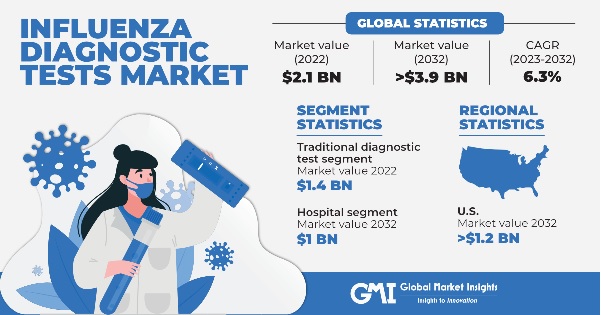


Influenza Diagnostic Tests Market
Get a free sample of this report
Your inquiry has been received. Our team will reach out to you with the required details via email. To ensure that you don't miss their response, kindly remember to check your spam folder as well!
Form submitted successfully!
Error submitting form. Please try again.

Request Sectional Data
Your inquiry has been received. Our team will reach out to you with the required details via email. To ensure that you don't miss their response, kindly remember to check your spam folder as well!
Form submitted successfully!
Error submitting form. Please try again.
Influenza Diagnostic Tests Market size was valued at around USD 2.1 billion in 2022 and is estimated to witness 6.3% CAGR between 2023 and 2032. The growing prevalence of influenza, rising demand for rapid diagnostic tests, and increase in R&D activities are some of the key factors driving the market progression.

According to data from the World Health Organization, in 2023, there were around a billion cases of seasonal influenza annually, including 3–5 million cases of severe illness. Moreover, influenza causes 290,000 to 650,000 respiratory deaths annually around the globe. The rise in the incidence of influenza cases, especially during seasonal outbreaks, has led to an increased demand for accurate and rapid influenza diagnostic tests (RIDT) for timely identification and management of the infection. As a result, the rising influenza cases coupled with the high mortality rate are expected to drive the market progress.
Influenza diagnostic tests refer to a range of medical procedures and technologies designed to identify the presence of influenza viruses in individuals suspected of having an influenza infection. These tests play a crucial role in the timely and accurate diagnosis of influenza, allowing healthcare professionals to initiate appropriate interventions, treatment, and public health measures.
| Report Attribute | Details |
|---|---|
| Base Year: | 2022 |
| Influenza Diagnostic Tests Market size in 2022: | USD 2.1 Billion |
| Forecast Period: | 2023 to 2032 |
| Forecast Period 2023 - 2032 CAGR: | 6.3 |
| 2023 Value Projection: | USD 3.9 Billion |
| Historical Data for: | 2018 to 2022 |
| No of Pages: | 180 |
| Tables, Charts & Figures: | 291 |
| Segments Covered: | Test Type, End-use, and Region |
| Growth Drivers: |
|
| Pitfalls Challenges: |
|
The market faces the potential risk of hindered growth due to stringent regulatory guidelines. These guidelines are implemented to uphold the safety and efficacy of diagnostic solutions, often resulting in lengthy approval processes for new influenza diagnostic tests. Companies may experience delays in bringing their products to market due to the comprehensive evaluations required by regulatory agencies. This, in turn, can impede the timely availability of innovative diagnostic solutions, potentially hindering the business landscape.
The COVID-19 pandemic significantly impacted the influenza diagnostic tests market in 2020. The coexistence of COVID-19 and influenza heightened the global demand for accurate testing. Governments emphasized surveillance for both infections, altering testing strategies. Supply chain disruptions affected test kit production and distribution, leading to operational challenges at testing facilities. Despite a modest decline in growth initially, the market swiftly rebounded due to increased awareness among patients and caregivers.
Rising advancements in influenza diagnostic tests intended to improve the speed, accuracy, and efficiency in the detection of influenza viruses will spur the business growth.

Based on test type, the market is segmented into traditional diagnostic test and molecular diagnostic assay. The traditional diagnostic test segment was valued at around USD 1.4 billion in 2022 and is expected to exhibit a robust growth trend throughout the analysis period.

Based on end-use, the influenza diagnostic tests market is segmented into hospitals, diagnostics centers, research laboratories, and others. The hospital segment is projected to reach more than USD 1 billion by the end of 2032.

The U.S. dominated the North American influenza diagnostic tests market with a significant market share in 2022 and is anticipated to expand at a notable pace to reach more than USD 1.2 billion by 2032.
The influenza diagnostic tests industry is fragmented in nature, with companies competing to offer superior influenza diagnostic tests in this business space. Prominent players such as F. Hoffmann-La Roche Ltd, Abbott, and Becton Dickinson and Company Inc hold a significant share in this market. These companies are diligently directing their efforts towards continuous type innovation to gain substantial market share.
Some of the eminent market participants operating in the influenza diagnostic tests industry include:
By Test Type, 2018 - 2032 (USD Million)
By End-use, 2018 - 2032 (USD Million)
The above information is provided for the following regions and countries:
The U.S. influenza diagnostic tests market is anticipated to expand at a notable pace to reach more than USD 1.2 billion by 2032, attributed to robust healthcare infrastructure, R&D initiatives, and high disease burden, and seasonal outbreaks.
F. Hoffmann-La Roche Ltd, Abbott, Becton, Dickinson, and Company, Coris BioConcept, DiaSorin SpA, Meridian Bioscience Inc., Quidel Corporation, Sekisui Diagnostics, Thermo Fischer Scientific Inc., and Hologic Inc.
The influenza diagnostic tests market was valued at around USD 2.1 billion in 2022 and is estimated to reach over USD 3.9 billion by 2032, backed by the growing prevalence of influenza, rising demand for rapid diagnostic tests, and increase in R&D activities.
The traditional diagnostic test segment was valued at around USD 1.4 billion in 2022 and is expected to exhibit a robust growth trend through 2032, owing to their ease of use, quick results, and cost-effectiveness.